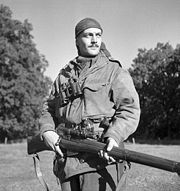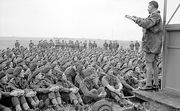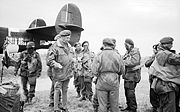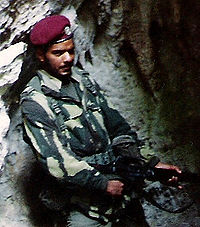
Denison smock
Encyclopedia

Special Operations Executive
The Special Operations Executive was a World War II organisation of the United Kingdom. It was officially formed by Prime Minister Winston Churchill and Minister of Economic Warfare Hugh Dalton on 22 July 1940, to conduct guerrilla warfare against the Axis powers and to instruct and aid local...
(SOE) agents, the Parachute Regiment, the Glider Pilot Regiment
Glider Pilot Regiment
The Glider Pilot Regiment was a British airborne forces unit of the Second World War which was responsible for crewing the British Army's military gliders and saw action in the European Theatre of World War II in support of Allied airborne operations...
, Air Landing Regiment
Air Landing Regiment
An Air Landing was the term used for British Army, glider-borne troops. Air Landing units included infantry battalions and light armoured regiments together with combat support and combat service support units and sub-units. The Glider Pilot Regiment provided the aircrew to fly the gliders into...
s, and other Commonwealth
Commonwealth of Nations
The Commonwealth of Nations, normally referred to as the Commonwealth and formerly known as the British Commonwealth, is an intergovernmental organisation of fifty-four independent member states...
airborne units
Airborne forces
Airborne forces are military units, usually light infantry, set up to be moved by aircraft and 'dropped' into battle. Thus they can be placed behind enemy lines, and have an ability to deploy almost anywhere with little warning...
, to wear over their Battle Dress
Battle Dress
Battle Dress was the specific title of a military uniform adopted by the British Army in the late 1930s and worn until the 1960s. Several other nations also introduced variants of Battle Dress during the Second World War, including Australia, Canada, India, New Zealand, South Africa, and the...
uniform during the Second World War
World War II
World War II, or the Second World War , was a global conflict lasting from 1939 to 1945, involving most of the world's nations—including all of the great powers—eventually forming two opposing military alliances: the Allies and the Axis...
.
The smock was initially worn over the paratrooper's webbing equipment, but under his parachute pack and harness, as its primary purpose was to prevent the wearer's equipment from snagging while emplaned or during a jump. It was equally useful for camouflage and as a windproof garment that provided a method of carrying ammunition or equipment. Contemporary photographs show that airborne troops preferred to wear the smocks under their webbing once they had landed.
Development
The smock replaced an expedient first issue khaki-drill paratroopParatrooper
Paratroopers are soldiers trained in parachuting and generally operate as part of an airborne force.Paratroopers are used for tactical advantage as they can be inserted into the battlefield from the air, thereby allowing them to be positioned in areas not accessible by land...
jump-jacket that had been directly copied in 1940 from the German parachutist’s
Fallschirmjäger
are German paratroopers. Together with the Gebirgsjäger they are perceived as the elite infantry units of the German Army....
Knochensack
Knochensack
Knochensack was the nickname for German parachute jump smocks designed to wear over a paratrooper's equipment made for the Luftwaffe Fallschirmjäger during World War II. They were made in a variety of camouflage patterns and made from tough cotton material.There were several models in use in 1936,...
("bone sack"). This first "smock" was designed to be stepped into and pulled up over the body like a set of overalls which had had the legs removed from mid-thigh. The new Denison smock was put on and removed by pulling over the head: the collar zipped open as far as the chest, making it a true smock
Smock-frock
A smock-frock or smock is an outer garment traditionally worn by rural workers, especially shepherds and waggoners, in parts of England and Wales from the early eighteenth century...
style. The zipper was covered by a cloth flap, which had no buttons or other method to fasten it down. Introduced in 1942, the "Airborne Smock Denison Camouflage" bore a camouflage pattern designed by a Major
Major
Major is a rank of commissioned officer, with corresponding ranks existing in almost every military in the world.When used unhyphenated, in conjunction with no other indicator of rank, the term refers to the rank just senior to that of an Army captain and just below the rank of lieutenant colonel. ...
Denison, a member of a camouflage unit under the command of eminent stage designer Oliver Messel
Oliver Messel
Oliver Hilary Sambourne Messel was an English artist and one of the foremost stage designers of the 20th century....
. An alternative name was the "Smock Denison Airborne Troops".
The Denison was a popular garment among officers who could acquire them—Company Sergeant Major
Company Sergeant Major
A company sergeant major is the senior non-commissioned soldier of a company in the armies of many Commonwealth countries, responsible for standards and discipline. In combat, his prime responsibility is the supply of ammunition to the company...
CC Martin, DCM, MM of The Queen's Own Rifles of Canada
The Queen's Own Rifles of Canada
The Queen's Own Rifles of Canada is a militia regiment within the Canadian Forces, based in Toronto, Ontario. The regiment is part of Land Force Central Area's 32 Canadian Brigade Group. It is the only Primary Reserve regiment in Canada to have a parachute role. The regiment consists of the reserve...
mentioned in his memoir Battle Diary that senior officers and sergeants major of his battalion wore the Denison universally.
1st Pattern
The smock was made from loose-fitting, yellowish-sand coloured, heavyweight twillTwill
Twill is a type of textile weave with a pattern of diagonal parallel ribs . This is done by passing the weft thread over one or more warp threads and then under two or more warp threads and so on, with a "step" or offset between rows to create the characteristic diagonal pattern. Because of this...
material, allegedly hand-painted with broad, mop like brushes using non-colourfast dyes in broad pea green and dark brown stripes, or "brush-strokes". With use the base colour faded to a sandy buff, and the overlaid shades gained a blended appearance. The colours of the 1st pattern smock were thought to best suit the wearer to the North African and Italian theatres. It had a half length zip fastener made of steel, knitted woollen cuffs, four external pockets that secured with brass snaps (two on the chest and two below the waist), two internal pockets on the chest, and epaulettes that secured with plastic battle dress buttons. The inside of the collar was lined with soft khaki flannel (or in senior officer's smocks, Angora wool). A “beaver tail” fastened beneath the crotch from the back to the front of the smock - which kept it from riding up during a parachute descent. When not used, the tail would hang down behind the wearer's knees, hence the nickname "men with tails", given by the Arabs in North Africa in 1942. The smock was styled as a very loose garment, since it would be worn over Battle Dress
Battle Dress
Battle Dress was the specific title of a military uniform adopted by the British Army in the late 1930s and worn until the 1960s. Several other nations also introduced variants of Battle Dress during the Second World War, including Australia, Canada, India, New Zealand, South Africa, and the...
, but it could be adjusted to some extent with tightening tabs on both sides of the lower part of the smock.
The smock was most commonly associated with British and Commonwealth airborne units
Airborne forces
Airborne forces are military units, usually light infantry, set up to be moved by aircraft and 'dropped' into battle. Thus they can be placed behind enemy lines, and have an ability to deploy almost anywhere with little warning...
, and the Special Air Service
Special Air Service
Special Air Service or SAS is a corps of the British Army constituted on 31 May 1950. They are part of the United Kingdom Special Forces and have served as a model for the special forces of many other countries all over the world...
Regiment, after D-Day, but its initial use was by members of the Special Operations Executive
Special Operations Executive
The Special Operations Executive was a World War II organisation of the United Kingdom. It was officially formed by Prime Minister Winston Churchill and Minister of Economic Warfare Hugh Dalton on 22 July 1940, to conduct guerrilla warfare against the Axis powers and to instruct and aid local...
(SOE), parachuted or landed into enemy territory between 1941 and 1944. In the early smocks the colours were meant to be impermanent and wash out, leaving the garment looking like a typical French artisan or labourer’s chemise
Chemise
The term chemise or shift can refer to the classic smock, or else can refer to certain modern types of women's undergarments and dresses...
, and thus, hopefully, aiding the wearer's Escape and Evasion chances. As the newly formed Airborne Forces expanded, so the need for smocks grew, meaning that they were by now screen printed for easier production.http://www.kamouflage.net/camouflage/en_00073.php
For use by Airborne troops, the Denison was worn over the battledress and under the webbing, with a sleeveless green denim oversmock being worn over the ensemble to prevent rigging lines snagging in the webbing and causing a 'chute malfunction. This sleeveless smock had a long external zipper (often removed and used to make the half-zip Denisons full zip), a monkey tail that press studded to the outside front of the oversmock and two elasticated open pockets on the lower front which were to hold grenades for use whilst in the air or immediately upon landing. After a successful parachute landing fall, the oversmock was discarded.
2nd Pattern

Variations


Grenade
A grenade is a small explosive device that is projected a safe distance away by its user. Soldiers called grenadiers specialize in the use of grenades. The term hand grenade refers any grenade designed to be hand thrown. Grenade Launchers are firearms designed to fire explosive projectile grenades...
s. These pockets were sometimes removed and added to the Denisons as well.

High ranking officers (see photographs) could buy a privately made version of the Denison. Made from a lighter weight gaberdine material, it had a full zip and a drawcord at the waist and a white wool liner to the collar. Frequently seen worn by General Montgomery and General 'Boy' Browning, OC Airborne Troops.
The Royal Marines used a version which had the half zip replaced with buttons and loops for fastening the opening.http://www5b.biglobe.ne.jp/~TANK-GUY/notes/SAS%20figure.html
A waterproof Denison in waxed dark green material was also very rarely found during the War.http://www5b.biglobe.ne.jp/~TANK-GUY/notes/SAS%20figure.html
Windproof Smock
A garment with a similar appearance and colours to the Denison, in lighter-weight denimDenim
Denim is a rugged cotton twill textile, in which the weft passes under two or more warp threads. This produces the familiar diagonal ribbing identifiable on the reverse of the fabric, which distinguishes denim from cotton duck. Denim has been in American usage since the late 18th century...
, the 1942 Pattern Smock, Windproof, was also commonly issued to scouts and snipers in infantry
Infantry
Infantrymen are soldiers who are specifically trained for the role of fighting on foot to engage the enemy face to face and have historically borne the brunt of the casualties of combat in wars. As the oldest branch of combat arms, they are the backbone of armies...
battalion
Battalion
A battalion is a military unit of around 300–1,200 soldiers usually consisting of between two and seven companies and typically commanded by either a Lieutenant Colonel or a Colonel...
s, from 1943, but most notably the SAS/SBS/SOE and Commando squads. It is sometimes incorrectly referred to as the "SAS Windproof". It was not designed much for parachuting, and lacked a crotch flap, having a drawstring hem instead. The most distinctive point of difference between 'Windproofs' and the Denison smock are that the former are hooded. A matching set of over-trousers was produced to complement the smock. Both items were screen printed with colour-fast pigments in a bold splinter design
Splinter pattern camouflage
Splinter pattern camouflage is a military camouflage pattern consisting of polygons.Splittermuster was developed by Germany in the late 1920s. Splittermuster was issued to practically all Wehrmacht units. The pattern consists of a disruptive pattern of hard-edged polygons, with sharp corners...
, with colours similar to that of the Denison.
Variations of the 'Windproof' have been the basic Special Forces smock until the present, with several alternative colours seen over the years - white (or at least natural cotton) for LRDG's desert use; olive green; black; and, in now very rare later issues of the Smock, Windproof, 1963 Pattern, the DPM
DPM
-Science and technology:* Damp-proof membrane, see damp proofing* Data Position Measurement* Diesel particulate matter, see diesel exhaust* Digital processing module, see digital signal processing...
introduced in the late 1960s. The current issue Smock, Windproof is in the latest variation of the DPM design.
The camouflage pattern of the "SAS Windproof" was used as the basis of the post WW2 Belgian Paratrooper Smock with very similar overtrousers.
SOE Jumpsuit
A camouflaged overall garment in a similar camouflage pattern along with a matching cloth helmet were issued to the SOE and allied agents parachuting into occupied Europe and were discarded shortly after descent. SOE jumpsuits were also issued in white for winter/actic environments.http://www.alliedforum.net/viewtopic.php?f=12&t=301Post war
The Denison smock (or Smock, camouflage on later garments) remained on inventories in Commonwealth and other militaries after the Second World War, and was popular with troops in Korea. It remained standard combat dress for the Royal MarinesRoyal Marines
The Corps of Her Majesty's Royal Marines, commonly just referred to as the Royal Marines , are the marine corps and amphibious infantry of the United Kingdom and, along with the Royal Navy and Royal Fleet Auxiliary, form the Naval Service...
and the Parachute Regiment until the mid 1970s (see below), and changed little from the wartime issue. A full length brass zip had become standard - with no cloth flap to cover it - and the ever-popular knitted cuffs (deleted on the 2nd Pattern smock, but often imitated by sewing woollen sock tops to the cuffs), were reintroduced. The base colour of the camouflage pattern was now a lighter khaki shade. The "Newey" press studs changed from brass/copper to nickel plated versions.
1959 Pattern


Replacement
The British Army had officially adopted a DPMDisruptive Pattern Material
Disruptive Pattern Material is the commonly used name of a camouflage pattern used by British forces as well many other armies worldwide, particularly in former British colonies....
combat uniform for general use in 1972, and a Smock, combat, DPM was introduced as the general issue jacket of the range. Both the Royal Marines
Royal Marines
The Corps of Her Majesty's Royal Marines, commonly just referred to as the Royal Marines , are the marine corps and amphibious infantry of the United Kingdom and, along with the Royal Navy and Royal Fleet Auxiliary, form the Naval Service...
and the Parachute Regiment continued to wear the Denison smock, (typically with olive green Trousers, combat, 1960 pattern for field use or "lightweight" trousers in barracks and walking-out) until the late 1970s.
"Although a status symbol in the British Army, the Denison," wrote ex-SAS officer, Barry Gregory, "was windproof but not waterproof and stank after use like a coal-miner's sweat shirt. I used it in extremis as a pillow when sleeping out with sleeping-bag and poncho to keep my head above ground level."
In the UK, the DPM Smock, Parachutist's began to replace the Denison smock (beginning in 1977), to the chagrin of most of their owners, and all the Denisons had disappeared before the Falklands War
Falklands War
The Falklands War , also called the Falklands Conflict or Falklands Crisis, was fought in 1982 between Argentina and the United Kingdom over the disputed Falkland Islands and South Georgia and the South Sandwich Islands...
of 1982. The new DPM replacement was not constructed of the Denison’s heavyweight twill, but was instead made from the same cotton material as the ’68-Pattern combat jacket. However, it was cut like the Denison smock, with smaller Newey press-stud (snap) fastened (but now bellowed) pockets, a full length zipper without buttons down the front, the traditional olive green knitted wool cuffs, and a 'crotch flap' on the outside of the back.
The Canadian Airborne Regiment was first issued an olive green replacement for the Denison in the 1950s, and in 1975 a Disruptive Pattern parachute smock entered service, remaining in the inventory until the regiment disbanded in 1995.
Legacy
Belgian special forces units serving with the British during the Second World War included the Belgian Special Air ServiceSpecial Air Service
Special Air Service or SAS is a corps of the British Army constituted on 31 May 1950. They are part of the United Kingdom Special Forces and have served as a model for the special forces of many other countries all over the world...
. On their return to Belgium after the war, the unit (and its successors)http://www.paracommando.com continued to wear the Denison Smock, with the design following a separate evolutionary path there.http://img152.exs.cx/img152/3843/smock0ek.jpg
The French SAS wore the Denison while fighting with Free French Forces
Free French Forces
The Free French Forces were French partisans in World War II who decided to continue fighting against the forces of the Axis powers after the surrender of France and subsequent German occupation and, in the case of Vichy France, collaboration with the Germans.-Definition:In many sources, Free...
to liberate France, and continued to wear it immediately after the War whilst in Indochina, along with surplus British M42 Windproof smocks and overtrousers (see above).http://codoponchardiersasb.ifrance.com/codoponchardiersasb/PgeUniformes.htm
Pattern
The characteristic “brushstroke” camouflage pattern used on the Denison Smock has had a notable influence on the development of camouflage clothing worldwide. As well as being the design antecedentAntecedent
An antecedent is a preceding event, condition, cause, phrase, or word. It may refer to:* Antecedent moisture, a hydrologic term describing the relative wetness condition of a sewershed.* Antecedent , the first half of a hypothetical proposition....
of its replacement, the four colour Disruptive Pattern
Disruptive Pattern Material
Disruptive Pattern Material is the commonly used name of a camouflage pattern used by British forces as well many other armies worldwide, particularly in former British colonies....
, the Denison clearly inspired camouflage patterns used by Belgium, France, Rhodesia, Pakistan, and India.
The most important development based on Denison pattern was the French Lizard
Lizard (camouflage)
The Lizard pattern is a kind of military camouflage pattern used by the French Army on uniforms beginning in the 1950s up to the late 1980s.-The Lizard pattern and its descendants:...
pattern, in which the green and brown brush-strokes were more frequent, but much smaller, on a light greyish green base. Lizard evolved into two main styles: vertical, and horizontal (indicating the general direction of the brushstrokes). Other developments changed the shape of the brushstrokes, using intricate grass-like patterns in the Rhodesian pattern, or palm frond-like sprays in the Indian pattern. South African Denison Smocks (later replaced by the Slangvel) were plain sand coloured.
See also
- DPM Parachute Smock Replacement of Denison Smock for British Army.
- Canadian Para SmockCanadian Para SmockThe Canadian Parachutist Smock was issued to the Canadian Airborne Regiment from 1975 until the regiment was disbanded in 1995 and to all units of 1 SSF Brigade including the 1st Battalion of The Royal Canadian Regiment based in London, Ontario. Made of 'Reverse DPM' camouflage, it is very similar...
DPM Smock, Similar to British Issue. - Smock Windproof DPMSmock Windproof DPMThe Smock, Windproof, DPM was issued alongside the standard DPM Combat Jackets by the British Army. The Special Air Service Regiment was the first unit to adopt its own design of DPM Windproof Smock which it wore in preference to the 68 Pattern and later combat jackets...
- British Army UniformBritish Army UniformBritish Army uniform currently exists in several grades, which are worn depending on the requirements of a unit or individual, ranging from ceremonial uniforms to combat dress.-History:...
- List of camouflage patterns
- KnochensackKnochensackKnochensack was the nickname for German parachute jump smocks designed to wear over a paratrooper's equipment made for the Luftwaffe Fallschirmjäger during World War II. They were made in a variety of camouflage patterns and made from tough cotton material.There were several models in use in 1936,...
- Slangvel South African issue Para Smock

